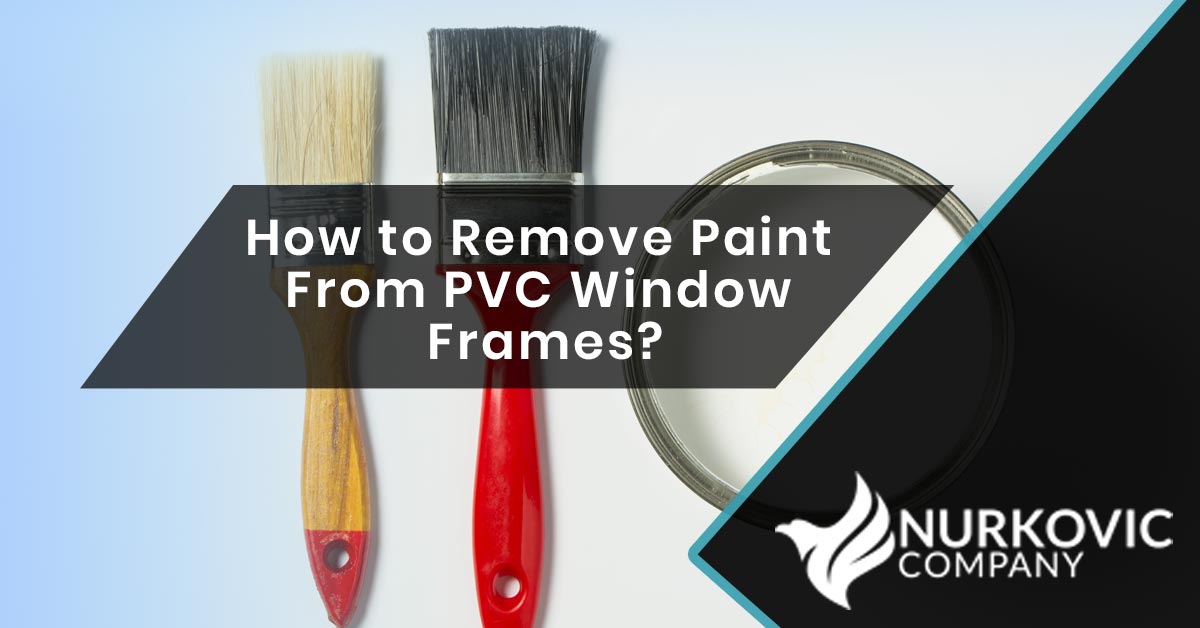So you taped the frame around the window to protect it while you painted the wall, removed the tape and discovered, to your horror, that the paint had bled under the tape and was now firmly attached to your pretty white PVC frame.
The paint should be easy to remove when wet, but it takes on a new shape that is difficult to change once it dries. This guide will show you how to remove paint from PVC window frames like a pro.

What should be considered before removing paint from PVC?
We know that removing paint from PVC window frames should be easy. However, there are several factors to consider before choosing the best method for your situation:
- What kind of color is it?
- How long has the paint been there?
- What type of paint are you removing?
The typical types of paint you’ll come across are emulsion and gloss, but you can also find a wood stain, mostly if it’s outside.
Aerosol paint can also find its way onto your window frame, especially if you used it as a stain block.
Some say you should try to remove the paint as soon as it gets on your PVC frame, while others suggest letting it dry and then dealing with it. Certainly, rubbing wet paint with a damp cloth can leave a thin layer that becomes difficult to remove compared to a thick dry stain.
Again, it all comes down to the type of paint, so before I go through my favorite method of removing paint from PVC, let’s explore the nature of the different types of paint.
Related Article: How Long Do PVC Windows Last?
Water-based paint
This category includes emulsion paints and some types of primers. Since they are water-based, these colors react well to a dish of soap and a sponge.
Acrylic paints are also water-based, and when they dry, they leave a transparent polymer film that retains the colored pigments. These colors require more than just soapy water, so keep reading and follow our step-by-step instructions below.
Solvent-based paint
Often called oil-based paints, these paints have a high level of organic compounds that provide a more durable finish than water-based paints.
Solvent-based paint does not adhere easily to plastic materials, so it is usually not necessary to soak them, just a light scraping.
Wood stain
One of the most difficult substances to remove is wood stain, which can be water-based or solvent-based.
Although designed for wood, the stain is incorporated into the surface when poured onto PVC. Not as much as with wood, but enough to make life difficult.
Wood stain usually spreads thinly across the surface, making it nearly impossible to scrape off without damaging the surface underneath.
How to remove paint from uPVC window frames – step by step instructions
Before you begin, make sure you have the following tools and materials:
- Tools and materials
- Kitchen rolling pin
- A sponge
- Soft fabric
- An old toothbrush
- 220-320 grit sandpaper (optional, only for heavy stains)
- Soapy water in a bucket
- Butyl or latex gloves
- Window cleaner
Did you understand all of the above? Great, let’s get started!
Step 1: Prepare the surface
Before preparing the surface, you must first determine whether you are dealing with a solvent-based or water-based paint.
You can often remove solvent-based paint by scraping it off the surface. Old credit cards are handy for this job – they’re stiff but not sharp enough to damage the PVC.
To start, use the narrow edge of a credit card and try to remove a small stain. If it comes off easily, you may not need to go any further. However, we recommend doing at least step 2 to ensure a nice clean frame.
Warm water applied with a piece of kitchen towel or sponge helps soften water-based paint. So try this technique before following the scraping instructions above and step 2 below.
Step 2: Consider a more abrasive approach (optional, for tough stains only)
If all else fails, use fine sandpaper to gently remove the paint.
Sanding will most likely remove some of the frame’s shine, but it looks less ugly than spray painting, especially if the paint is a very contrasting color.
With tough stains like wood stain, don’t try too hard to remove the discoloration or you’ll take away too much surface area. In this case, just sand enough to break through the finish and go back to step 2.
Step 3: Cleaning the frame
This step is where you’ll put some shine back into your frame.
Any window cleaner will do, but thicker creams work better to restore some shine to your PVC frame.
Apply the cream to the frame using a sponge and plenty of elbow grease. Apply the cream to the treated area and beyond. The idea is to blend in and look natural.
When finished, wipe down the entire frame with a fresh bowl of soapy water and a soft cloth. Dry with kitchen roll.
So that’s it. The best way to remove paint from PVC window frames is to use common household products.




